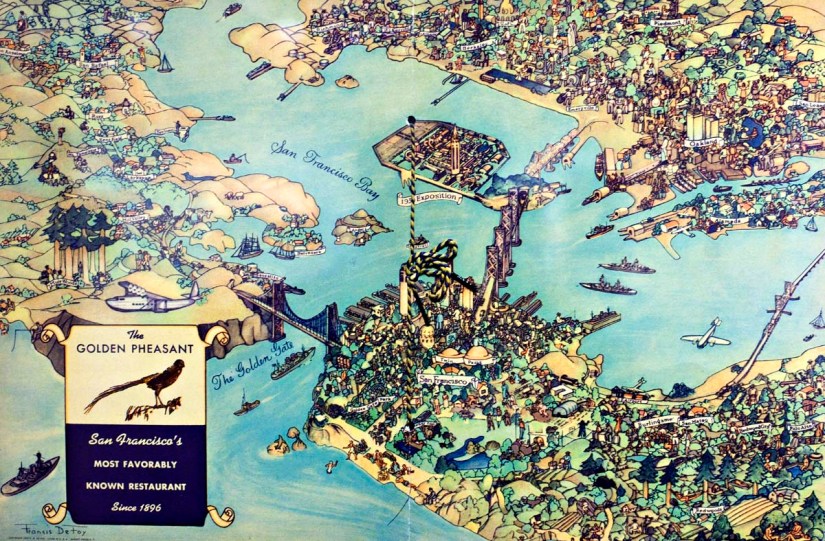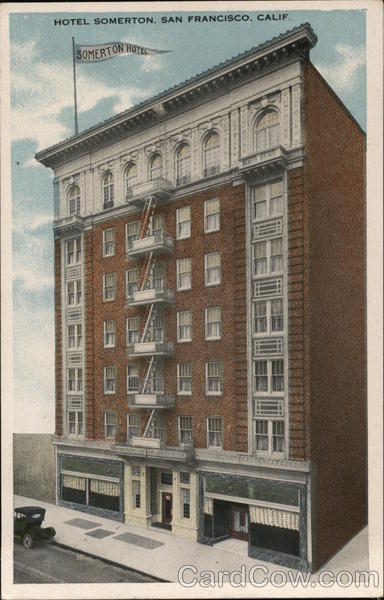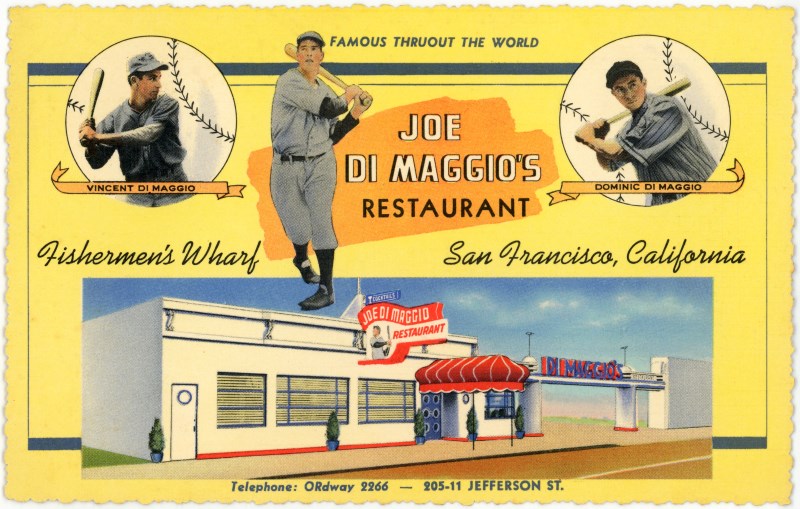
Original publish date: March 15, 2011
Anyone familiar with my columns knows that I have a love for historical objects. In my travels to antique shops, malls and shows I often run across amazing things. Some I purchase, some I simply gaze at in awe and some I peruse carefully and leave for another collector to find and enjoy. One such object was a 1944 WWII wartime visitor’s book titled “Something Doing in San Francisco” that featured a full back cover ad for “Acme Beer” that featured a shapely young woman in a bathing suit holding a glass of beer who looked amazingly like a young Norma Jeane Baker aka Marilyn Monroe. I picked it up and took a closer look and, alas, it was not an undiscovered Marilyn. However when I flipped through the pages, I was rewarded with a brief glimpse into World War II San Francisco through the eyes of a visitor from “America’s greatest generation.”
 The little pocket sized booklet was full of info, maps and pictures from homefront San Francisco, one of America’s busiest ports of call during the war. These were obviously handed out to visiting GI’s and associated personnel for use as a handy visitor’s reference for the city by the bay. Fisherman’s Wharf, the Golden Gate Bridge, Coit Tower, Streetcars, Alcatraz, they were all covered in depth within its pages. In the back of the booklet were several “Diary” pages for the owner to quickly jot down their thoughts before they became memories and that is exactly what the previous owner did, carefully recording in pencil details of their August 1944 visit to the “Frisco.” The best way I can present it to you is exactly as I read it, so here are the words verbatim: “U.S.H.B.
The little pocket sized booklet was full of info, maps and pictures from homefront San Francisco, one of America’s busiest ports of call during the war. These were obviously handed out to visiting GI’s and associated personnel for use as a handy visitor’s reference for the city by the bay. Fisherman’s Wharf, the Golden Gate Bridge, Coit Tower, Streetcars, Alcatraz, they were all covered in depth within its pages. In the back of the booklet were several “Diary” pages for the owner to quickly jot down their thoughts before they became memories and that is exactly what the previous owner did, carefully recording in pencil details of their August 1944 visit to the “Frisco.” The best way I can present it to you is exactly as I read it, so here are the words verbatim: “U.S.H.B.
 Phyllis Schwalbe Douglas 8800 Room 330 Fairmont Hotel Wed.-Station-shopped. Ernie Pyle stopped in the souvenir shop. The girl was reading August Mademoiselle. Phyl asked if she might see it-she hadn’t seen it since it was all sent to print. Sure enough, her name was in it several times. The girl was going to study Marine Zoology at U. of Cal. Phyl may come to San Diego, L.A., Tijuana, etc. sometime soon. Bill is also gobs of fun-Boston-Yale and Harvard Man. We parted ways. They are very much fun! Then rushed over to Curran Theater to see stage prod. of Rose Marie, starring Irene Manning. Very nice and very well done. Then to Golden Pheasant for a lush hot caramel sundae.
Phyllis Schwalbe Douglas 8800 Room 330 Fairmont Hotel Wed.-Station-shopped. Ernie Pyle stopped in the souvenir shop. The girl was reading August Mademoiselle. Phyl asked if she might see it-she hadn’t seen it since it was all sent to print. Sure enough, her name was in it several times. The girl was going to study Marine Zoology at U. of Cal. Phyl may come to San Diego, L.A., Tijuana, etc. sometime soon. Bill is also gobs of fun-Boston-Yale and Harvard Man. We parted ways. They are very much fun! Then rushed over to Curran Theater to see stage prod. of Rose Marie, starring Irene Manning. Very nice and very well done. Then to Golden Pheasant for a lush hot caramel sundae.
 Thurs.-Hotel Somerton-Dick Came at 1:00-Went across Oakland Bay bridge by Treasure Island to U. of Cal. Lovely! Walked around campus. Went by the docks to Ft. Mason. Wonderful view of Bay, Golden Gate Bridge, Alcatraz. Ate at Officer’s club with Bob & Dotty Byers, Bob Harper and _____? Listened to piano music and requested songs. Walked around Ft. and saw Golden Gate lighted up! Went to Chinatown and International Settlement-took in a few dives-danced.
Thurs.-Hotel Somerton-Dick Came at 1:00-Went across Oakland Bay bridge by Treasure Island to U. of Cal. Lovely! Walked around campus. Went by the docks to Ft. Mason. Wonderful view of Bay, Golden Gate Bridge, Alcatraz. Ate at Officer’s club with Bob & Dotty Byers, Bob Harper and _____? Listened to piano music and requested songs. Walked around Ft. and saw Golden Gate lighted up! Went to Chinatown and International Settlement-took in a few dives-danced.
Fri. Slept til 13:30-Called Phyllis Schwalbe up. Met her for lunch. Ate at St. Francis Hotel. Very nice girl from N.Y. Met Holyoke College Board Editor for Mademoiselle. Very fascinating!! We went to all big stores and Gump’s Oriental art display. Bought ourselves a flower ( 50 cents for each) Then went home. Dick Came at 5:00 and we went to Top of Marc to meet Phyl and Bill Levine. They didn’t show up so I called them. We went over to Cirque room of Fairmount hotel to meet them. Danced! Went to eat at Birch Room of the Fairmount Hotel.
 Sat. Me + Phyl again at 12:00. Had lunch at El Prado in Plaza Hotel. Rode cable car up the huge hill and out to Fisherman’s Wharf. Went to Joe DiMaggio’s. Saw all the boats. Went out on a big plank, climbed a tower and got a wonderful view of city. Saw…”
Sat. Me + Phyl again at 12:00. Had lunch at El Prado in Plaza Hotel. Rode cable car up the huge hill and out to Fisherman’s Wharf. Went to Joe DiMaggio’s. Saw all the boats. Went out on a big plank, climbed a tower and got a wonderful view of city. Saw…”
Dot, Dot, Dot. That’s exactly how the little story ended. As if to say that the story continued, just not on the pages of this little book. And how!
The places and names that pepper this long lost account beckon to anyone who has every visited San Francisco. They instantly conjure up dreamful images of fog city trips gone-by. When this account was penciled in, Alcatraz was a working Federal penitentiary, Franklin D. Roosevelt was on his way to an unprecedented 4th term as President, America was fighting a two-front war with the outcome still in doubt, and Japanese radio was piping in propaganda from the infamous Tokyo Rose most every night to the Bay area, whether you wanted to hear it or not.

The references in this first hand travel account resonate through the pages of history. If this were a movie, now would be the time when the flashback occurs. After the attack on Pearl Harbor, Fort Mason became the primary port of embarkation for service members shipping out to the Pacific Theater of Operations. Over the years of the war, 1,647,174 passengers and 23,589,472 measured tons moved from the port into the Pacific. This total represents two-thirds of all troops sent into the Pacific and more than one-half of all Army cargo moved through West Coast ports.
 Joe DiMaggio’s restaurant on Fisherman’s wharf was THE place to eat and be seen in San Francisco. Joltin’ Joe DiMaggio was perhaps the most famous player in all of baseball as the smooth as glass center-fielder for the New York Yankees. When this diary account was written DiMaggio was in the middle of a two-and-a-half year stint in the army air forces. The Yankee Clipper rose to the rank of Sergeant even though his parents, Giuseppe and Rosalia, were among the thousands of German, Japanese and Italian immigrants classified as “enemy aliens” by the government after Pearl Harbor. The DiMaggio’s had to carry photo ID booklets at all times, and were not allowed to travel outside a five mile radius from their home without a permit. Giuseppe was barred from the San Francisco Bay, where he had raised his 3 Major League boys (Joe, Dom, and Vince) and fished for decades (Giuseppe’s boat was seized). DiMaggio resumed his baseball career and landed in the Hall of Fame and DiMaggio’s restaurant remained a Bay area hotspot for another 40 years.
Joe DiMaggio’s restaurant on Fisherman’s wharf was THE place to eat and be seen in San Francisco. Joltin’ Joe DiMaggio was perhaps the most famous player in all of baseball as the smooth as glass center-fielder for the New York Yankees. When this diary account was written DiMaggio was in the middle of a two-and-a-half year stint in the army air forces. The Yankee Clipper rose to the rank of Sergeant even though his parents, Giuseppe and Rosalia, were among the thousands of German, Japanese and Italian immigrants classified as “enemy aliens” by the government after Pearl Harbor. The DiMaggio’s had to carry photo ID booklets at all times, and were not allowed to travel outside a five mile radius from their home without a permit. Giuseppe was barred from the San Francisco Bay, where he had raised his 3 Major League boys (Joe, Dom, and Vince) and fished for decades (Giuseppe’s boat was seized). DiMaggio resumed his baseball career and landed in the Hall of Fame and DiMaggio’s restaurant remained a Bay area hotspot for another 40 years.
 The St. Francis Hotel’s two twelve-story wings were famous for surviving the San Francisco Earthquake in 1904. During World War II, the shops in the hotel’s lobby were turned into small rooms for military officers. Hundreds of soldiers, sailors and officers danced in the Mural Room of the St. Francis to the big band music of Harry Owens and the Royal Hawaiians, and his vocalist, Hilo Hattie. Less than a year after this diary account was written, in April 1945 the St. Francis played host to twenty-seven delegations attending the founding meeting of the United Nations in San Francisco. The French foreign minister stayed in the same suite where the Fatty Arbuckle scandal had taken place. The St. Francis became the hotel where Republican presidents stayed when in San Francisco, while Democratic presidents usually stayed at the Fairmont. President Gerald Ford was almost shot while leaving the hotel in September, 1975 by Sara Jane Moore. Ronald Reagan was a frequent guest of the hotel as was Queen Elizabeth II of the United Kingdom and Emperor Hirohito of Japan.
The St. Francis Hotel’s two twelve-story wings were famous for surviving the San Francisco Earthquake in 1904. During World War II, the shops in the hotel’s lobby were turned into small rooms for military officers. Hundreds of soldiers, sailors and officers danced in the Mural Room of the St. Francis to the big band music of Harry Owens and the Royal Hawaiians, and his vocalist, Hilo Hattie. Less than a year after this diary account was written, in April 1945 the St. Francis played host to twenty-seven delegations attending the founding meeting of the United Nations in San Francisco. The French foreign minister stayed in the same suite where the Fatty Arbuckle scandal had taken place. The St. Francis became the hotel where Republican presidents stayed when in San Francisco, while Democratic presidents usually stayed at the Fairmont. President Gerald Ford was almost shot while leaving the hotel in September, 1975 by Sara Jane Moore. Ronald Reagan was a frequent guest of the hotel as was Queen Elizabeth II of the United Kingdom and Emperor Hirohito of Japan.
Ernie Pyle was perhaps the 3rd most famous man in America behind President Roosevelt and General Dwight “Ike” Eisenhower. Pyle was a Pulitzer Prize winning journalist known as the “GI’s friend.” Of the many names and places referenced in this quaint little travel account, this is the one that touched me the most. Pyle, a native of Dana, Indiana, has long been a hero of mine. At the time this diary account was written, Pyle was returning to the states after his tour of duty as one of the twenty-eight correspondents who covered the D-Day invasion of Normandy on 6 June 1944 and following the Allied armies into Paris. His distinguished correspondence during this period won him the Pulitzer Prize in 1944, as well as two honorary degrees. In 1944, he wrote a column urging that soldiers in combat get “fight pay” just as airmen were paid “flight pay.” Congress passed a law authorizing $10 a month extra pay for combat infantrymen. The legislation was called “The Ernie Pyle bill.” Ernie was at the top of his game.
Pyle was arriving in the port of San Francisco for a brief sojourn back in States, during which his troubled wife Geraldine suffered a mental illness relapse and was hospitalized. This diary account touched me because I can imagine Pyle arriving in port and walking immediately into a gift shop to buy a gift for Geraldine. Ernie and Geraldine “Jerry” Siebolds, his “fearful and troubled wife”, carried on a tempestuous relationship for twenty years. Jerry suffered from intermittent bouts of mental illness and alcoholism. Pyle described her as “desperate within herself since the day she was born”. The two were divorced on April 14, 1942, and remarried by proxy while Pyle was in Africa on March 10, 1943. This trip back to the states would be Ernie’s last.

Pyle went to cover the war in the Pacific in 1945, landing with the troops at Okinawa. Ernie was noted for having premonitions of his own death and predicted before landing that he would not be alive a year hence. On April 18, 1945, Pyle died on an island off Okinawa after being hit by Japanese machine-gun fire. He was travelling in a jeep with Lieutenant Colonel Joseph B. Coolidge (commanding officer of the 305th Infantry Regiment, 77th Infantry Division) and three other men. As the vehicle reached a road junction, an enemy machine gun about a third of a mile away began firing at them. The men stopped and jumped into a ditch. Pyle raised his head, smiled and asked Coolidge “Are you all right?” Those were his last words. The machine gun began shooting again, and Pyle was struck in the left temple-Pyle was killed instantly. President Truman awarded him the Medal of Merit posthumously, Pyle was among the few American civilians killed during the war to be awarded the Purple Heart. All less than a year after our diarist saw Ernie Pyle walk into a San Francisco gift shop.
Although the name of the diarist is lost to posterity, she did leave us one clue in the name of her friend “Phyl” or Phyllis Schwalbe. Well, “Phyl” graduated from Holyoke College in 1941 and went on to a distinguished writing career. She married Wilbur A. Levin, New York’s Kings County clerk and longtime New York City civic and business leader. Phyllis Lee Levin is a former reporter and columnist for The New York Times and a former editor and feature writer at Mademoiselle, Harper’s Bazaar, and Vogue. She is the author of several books, including Abigail Adams, Great Historic Houses of America, and ”Edith and Woodrow: The Wilson White House” and today she lives in New York City. And the diary? Well, after reading and carefully recording its pencil written personal comments, I placed it back where I found it. A treasure for another set of eyes to gaze upon on some other day. I only hope that reader enjoys it as much as I did.

